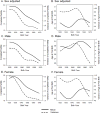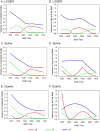Genotype × cohort interaction on completed fertility and age at first birth
- PMID: 25491394
- PMCID: PMC4289659
- DOI: 10.1007/s10519-014-9693-3
Genotype × cohort interaction on completed fertility and age at first birth
Abstract
Microevolutionary projections use empirical estimates of genetic covariation between physical or psychological phenotypes and reproductive success to forecast changes in the population distributions of those phenotypes over time. The validity of these projections depends on relatively consistent heritabilities of fertility-relevant outcomes and consistent genetic covariation between fertility and other physical or psychological phenotypes across generations. However, well-documented, rapidly changing mean trends in the level and timing of fertility may have been accompanied by differences in the genetic mechanisms of fertility. Using a sample of 933 adult twin pairs from the Midlife Development in the United States study, we demonstrate that genetic influences on completed fertility and age at first birth were trivial for the 1920-1935 birth cohort, but rose substantially for the 1936-1955 birth cohort. For the 1956-1970 birth cohort, genetic influences on completed fertility, but not age at first birth, persisted. Because the heritability of fertility is subject to change dynamically with the social context, it is difficult to project selection pressures or the rate at which selection will occur.
Conflict of interest statement
Daniel A. Briley, K. Paige Harden, & Elliot M. Tucker-Drob declare that they have no conflict of interest.
Figures




References
-
- Billari FC, Kohler H-P, Andersson G, Lundström H. Approaching the limit: Long-term trends in late and very late fertility. Pop Dev Rev. 2007;33(1):149–170.
-
- Bishop B. The Big Sort: Why the Clustering of Like-Minded America is Tearing us Apart. New York, NY: Houghton Mifflin; 2009.
-
- Bouchard TJ, Jr, McGue M. Genetic and environmental influences on human psychological differences. Dev Neurobio. 2003;54:4–45. - PubMed
-
- Bras H, Van Bavel J, Mandemakers K. Unraveling the intergenerational transmission of fertility: Genetic and shared-environment effects during the demographic transition in the Netherlands, 1810–1910. Hist Fam. 2013;18(2):116–134.
Publication types
MeSH terms
Grants and funding
LinkOut - more resources
Full Text Sources
Other Literature Sources

